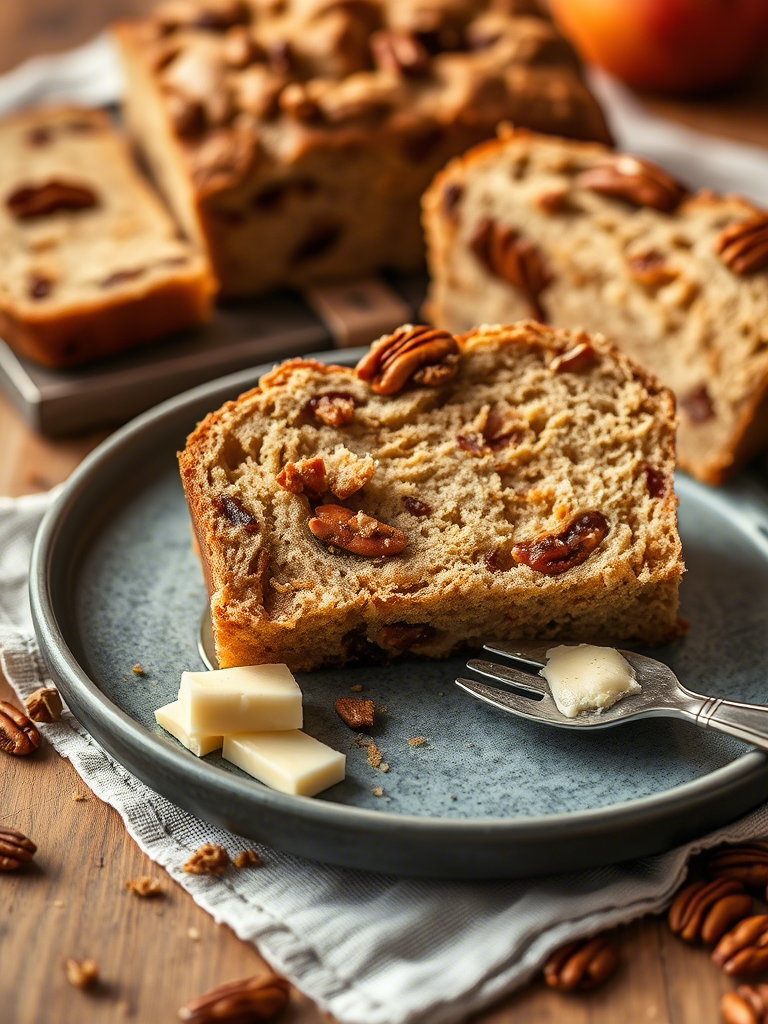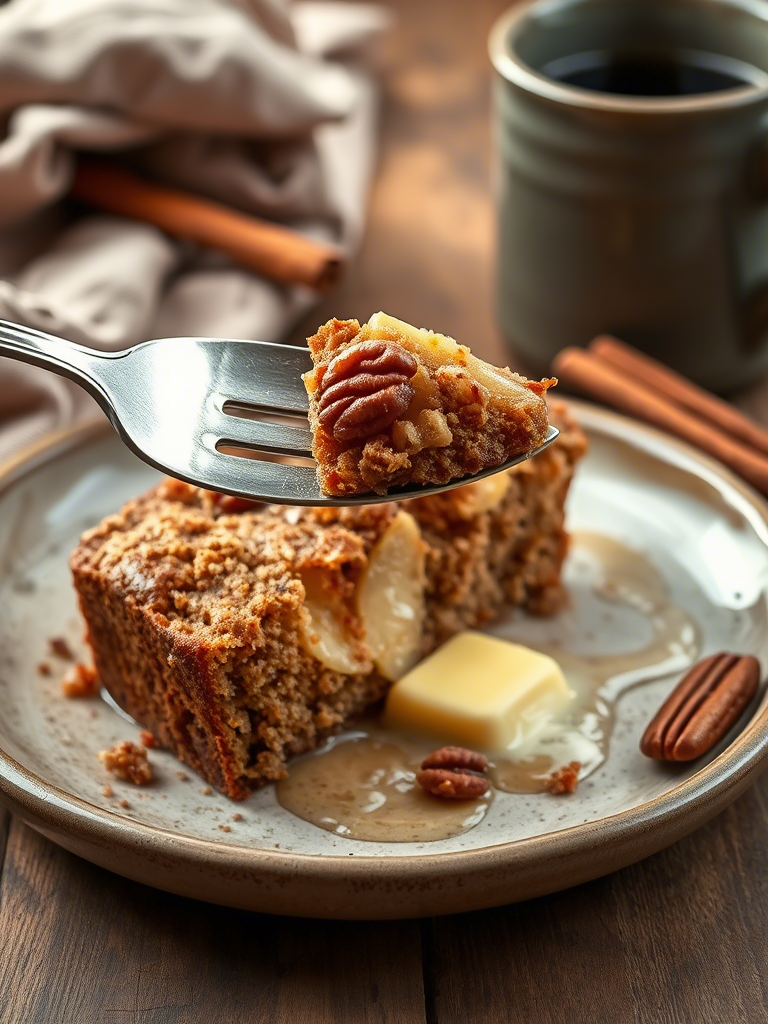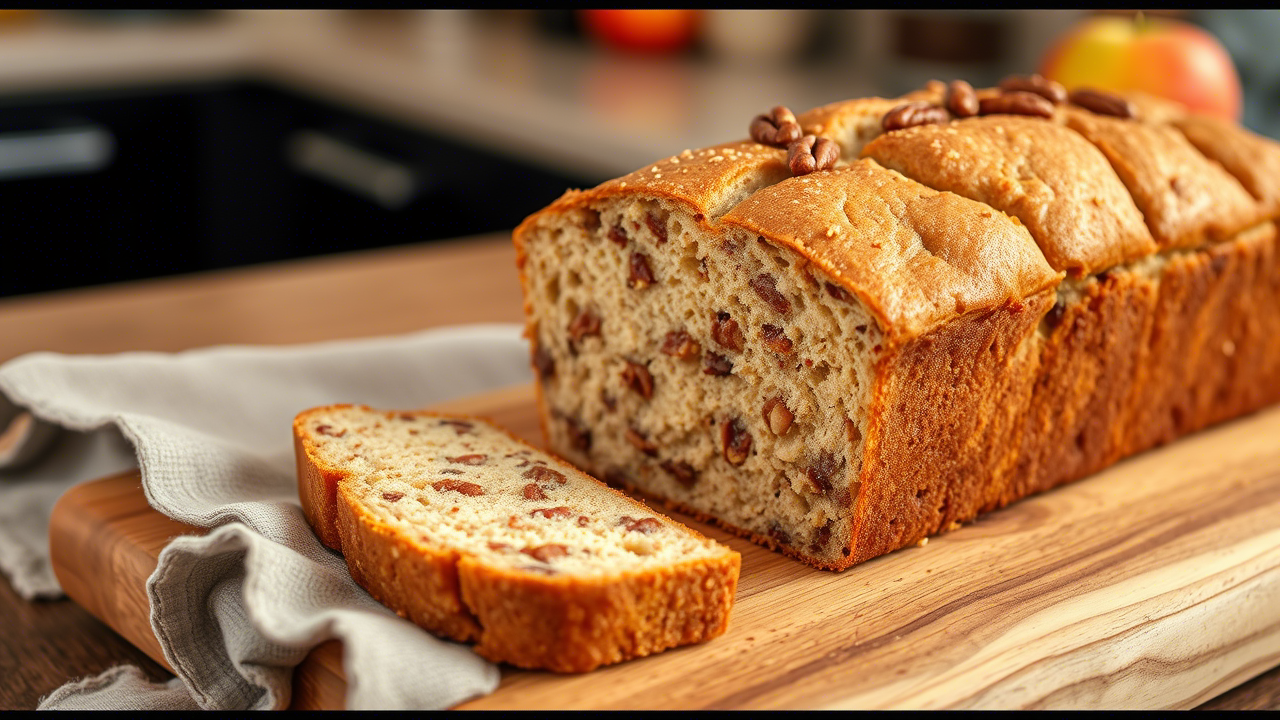You ever pull a loaf out of the oven and think, this ain’t just food, this is art? That’s the kind of spell Apple Cinnamon Pecan Bread casts. It’s a humble loaf, yeah, but hiding inside is a deeply fragrant world where autumn lives all year long.
This isn’t just another sweet bread. This is layers of warmth, crunch, softness, and soul. For professionals in baking, it’s a canvas that whispers tradition while letting technique flex.
Today, I’m not just giving you a recipe. I’m laying out the science, the nuance, the soul behind making Apple Cinnamon Pecan Bread that doesn’t just sit on a plate—it tells a story.
What Exactly Is Apple Cinnamon Pecan Bread?
It’s not quite cake. Not quite a classic yeast bread either. It leans closer to a quick bread—think banana bread, zucchini loaf, or pumpkin spice variations.
But unlike those, the apple-cinnamon-pecan trifecta brings in more layered complexity. The apples offer moisture and sweetness. Cinnamon wraps it all in warm spice. Pecans? Oh, they bring that earthy crunch that no walnut ever could.
The base is usually all-purpose flour, baking soda or powder, brown sugar, and a neutral oil or butter. But the magic’s in the ratios and the bake time. One wrong nudge and the crumb collapses or the loaf gets gummy.
It ain’t just throw-and-go. There’s structure here.
Why Professionals Love This Bread (And You Should Too)
Honestly, most pros know the draw: it’s adaptable, it’s shelf-stable for days, and it walks that fine line between rustic and refined.
Here’s a rundown of why it matters in commercial and boutique baking:
- Shelf Life: Thanks to the high moisture content of apples and the density of the crumb, this bread keeps soft for 3–4 days without preservatives.
- Seasonal Appeal: Peak apple months (September through November) mean menu features and seasonal specials.
- Consumer Demand: According to a 2023 report by Technomic, cinnamon and apple are in the top 10 flavors consumers associate with comfort. That matters when you’re designing for emotional triggers.
- Versatility: Serve it warm with butter at a café. Toast it and dollop on Greek yogurt and honey. Or cube it into a luxe bread pudding.

The Ingredients: More Than Just a Grocery List
If you think it’s all about measuring and mixing, you’re missing the plot. Each ingredient has a job. Sometimes two.
Apples
Don’t just grab any apple. You want structure and tang. Granny Smith? Great. Honeycrisp? Even better if you want a touch more sweetness.
Chop, don’t grate. Grated apples vanish. Chopped ones hold texture.
A good rule? 1.5 cups diced apple per loaf. Not puree, not sauce—apple.
Cinnamon
Ceylon vs Cassia. Yeah, it matters.
Cassia cinnamon is what most of us know—cheap, potent, intense. Great for big flavor. Ceylon’s milder, with citrus notes.
If you’re selling to a discerning crowd? Go Ceylon. Casual comfort bake? Cassia’s your workhorse.
Use 1.5 teaspoons minimum. Go up to 2.5 if you want a bold kick.
Pecans
Raw, not roasted. Toasted? Maybe, but do it fresh.
Chop ’em rough. You want people to see those bits. Not get lost in the crumb.
¼ to ½ cup is ideal. Toasting before folding them in wakes up the oils. Don’t skip it unless you’re in a real rush.
Fat
Butter brings flavor, oil brings moisture. Want best of both worlds? Use both. ¼ cup unsalted butter + ¼ cup neutral oil (canola or grapeseed) hits the spot.
If you go all butter, it’ll taste better, but won’t stay moist as long. All oil? It stays tender, but loses depth.
Trade-offs, always.
Sugar
Brown sugar is non-negotiable. White sugar makes it dry and boring.
Light brown sugar keeps it mellow. Dark brown? Go for it if you want molasses notes. ¾ cup is the sweet spot.
Eggs and Leavening
Two eggs. Not three. You’re baking a bread, not a custard.
Baking soda needs acid to activate—so use some yogurt or buttermilk. ½ cup of plain full-fat yogurt balances the base perfectly.
Add 1 teaspoon baking soda + ½ teaspoon baking powder for good rise without over-puffing.
The Method: Mixing Ain’t Just Mixing
If you dump it all together and stir, you’ll get gluey bread. Gluten ain’t forgiving.
Here’s how the technique really breaks down:
- Mix dry ingredients in a separate bowl – flour, cinnamon, salt, soda, powder, chopped pecans.
- Cream the butter, oil, and sugar till fluffy-ish. Then add eggs one at a time.
- Fold in the yogurt and chopped apples. Be gentle. You’re building a wet base.
- Add dry to wet in batches. Not all at once. Over-mixing here kills the rise.
- Pour into a greased loaf tin. Use parchment. You’ll thank yourself later.
Bake at 350°F for about 55–65 minutes. Depends on your oven. Always test with a skewer or thermometer (look for 200–205°F internal).
Let it cool. No slicing hot. That’s rookie stuff.

Advanced Tips for Pros in the Industry
You wanna charge $9.50 a slice at a café? Elevate the loaf.
- Brown Butter Glaze: Brown some butter, whisk with powdered sugar and vanilla, and drizzle once cooled. Adds luxe appeal.
- Apple Compote Swirl: Fold in a homemade compote to create visual layers.
- Pecan Crumble Top: Brown sugar, butter, oats, flour, chopped pecans—mix and sprinkle on top before baking.
Also: Control your moisture. Professional kitchens often weigh apples after chopping to ensure consistency. Moisture content varies dramatically between apple types and even regions.
One 2022 study from UC Davis showed that Granny Smiths grown in California retained 18% more moisture than the same cultivar from Oregon. That’s wild.
Common Pitfalls and How to Dodge ‘Em
Bread Collapses After Baking
This usually means over-mixing or under-baking. Check internal temp next time. Don’t guess.
Soggy Bottom (The Paul Hollywood Dread)
Too much moisture or too low heat. Use a metal pan, not glass. And always preheat the oven thoroughly.
Tastes Bland
You probably didn’t add enough salt. Even sweet breads need it. ½ teaspoon fine sea salt helps everything pop.
Or your cinnamon’s old. Yes, that happens. Ground cinnamon loses potency in six months. No lie.
Emerging Trends: Where Apple Cinnamon Pecan Bread Is Headed
Yeah, we’re talking about bread here. But trends don’t skip this category.
- Gluten-Free Versions: More brands are adapting with oat flour, almond meal, and xanthan gum stabilizers.
- Plant-Based Adaptations: Aquafaba and flax eggs are gaining popularity. But shelf life dips, so packaging becomes crucial.
- Hyperlocal Ingredients: Locally sourced apples or single-origin cinnamon now sell stories as much as flavors.
- Savory Twists: I’ve seen bacon bits and thyme being folded into test batches in New York test kitchens. Wild, but it works.
What Do You Serve It With?
It’s flexible.
Morning? Pair with strong coffee or chai. Midday? Serve with a soft cheese like brie or a tangy goat’s milk spread.
Dessert? A scoop of cinnamon ice cream and a whiskey caramel sauce takes it straight to fine dining.
This loaf ain’t shy—it plays well with others.
Final Thoughts: Mastery Through Simplicity
Apple Cinnamon Pecan Bread is proof that complexity doesn’t always wear a fancy coat. It’s a loaf rooted in simplicity, but that doesn’t mean it’s simple to master.
Every step is an opportunity to mess it up—or elevate it beyond anything on the grocery shelf.
Whether you’re a pastry chef in a high-volume bakery or a niche artisan baker building a cult following, this bread offers space to play, refine, and perfect.
Don’t treat it like a filler on your menu. Treat it like what it is: a quietly powerful showcase of texture, timing, and restraint.
Get your ratios right. Choose your apples with care. Toast your pecans like it matters—because it really, really does.
Then bake like you mean it.
FAQs
What kind of apples are best for Apple Cinnamon Pecan Bread?
Use firm, tart apples like Granny Smith or sweet-crisp ones like Honeycrisp for best texture and flavor.
Can I use oil instead of butter in the recipe?
Yes, but using a mix of butter and oil gives both moisture and rich flavor.
Should pecans be raw or toasted?
Toasted pecans are preferred—they add more flavor and aroma than raw ones.
How long does Apple Cinnamon Pecan Bread stay fresh?
It stays fresh for about 3–4 days when stored in an airtight container at room temperature.
Can this bread be made gluten-free?
Yes, substitute with gluten-free flour blends, but you may need to tweak moisture ratios.
Why did my loaf collapse in the middle?
Most likely due to over-mixing the batter or underbaking—check internal temp next time.
What’s the ideal internal temperature when the loaf is done?
The center should reach between 200°F and 205°F for a fully baked, stable crumb.
Can I make this recipe vegan?
Yes, with flax eggs and plant-based yogurt, but expect a slightly denser texture.
What’s the best pan to use for baking this bread?
A metal loaf pan works best; glass or ceramic can cause uneven baking.
Can I freeze Apple Cinnamon Pecan Bread?
Absolutely—wrap it well and freeze for up to 2 months, then thaw at room temp.
Can I reduce the sugar without ruining the bread?
Yes, but don’t cut more than 25% or you’ll lose moisture and balance.
Is it okay to add other spices?
Definitely—nutmeg, cloves, or cardamom can add lovely depth alongside the cinnamon.
What causes a soggy bottom in this bread?
Usually excess apple moisture or underbaking; draining chopped apples can help.
Do I need to peel the apples first?
Peeling is optional, but peeled apples blend better into the texture.
How can I elevate the loaf for bakery sales?
Add a brown butter glaze, a pecan crumble topping, or swirl in fresh apple compote.

Mariana is a passionate home cook who creates delicious, easy-to-follow recipes for busy people. From energizing breakfasts to satisfying dinners and indulgent desserts, her dishes are designed to fuel both your body and hustle.
When she’s not in the kitchen, she’s exploring new flavors and dreaming up her next recipe to share with the Foodie Hustle community.

